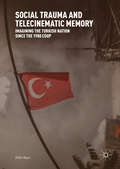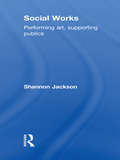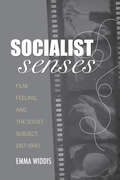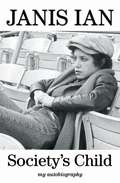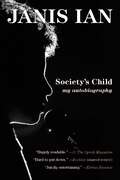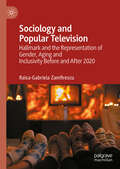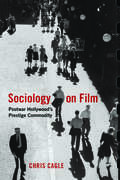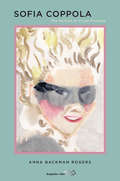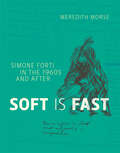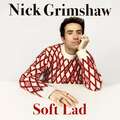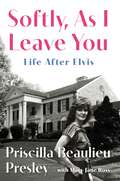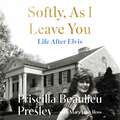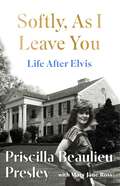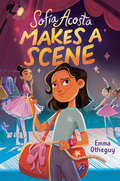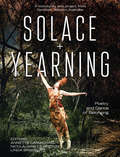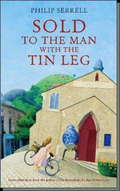- Table View
- List View
Social Trauma and Telecinematic Memory
by Pelin BaşcıThis book explores responses to authoritarianism in Turkish society through popular culture by examining feature films and television serials produced between 1980 and 2010 about the 1980 coup. Envisioned as an interdisciplinary study in cultural studies rather than a disciplinary work on cinema, the book advocates for an understanding of popular culture in discerning emerging narratives of nationhood. Through feature films and television serials directly dealing with the coup of 1980, the book exposes tropes and discursive continuities such as "childhood" and "the child". It argues that these conventional tropes enable popular debates on the modern nation's history and its myths of identity.
Social Works: Performing Art, Supporting Publics
by Shannon Jackson‘a game-changer, a must-read for scholars, students and artists alike’ – Tom Finkelpearl At a time when art world critics and curators heavily debate the social, and when community organizers and civic activists are reconsidering the role of aesthetics in social reform, this book makes explicit some of the contradictions and competing stakes of contemporary experimental art-making. Social Works is an interdisciplinary approach to the forms, goals and histories of innovative social practice in both contemporary performance and visual art. Shannon Jackson uses a range of case studies and contemporary methodologies to mediate between the fields of visual and performance studies. The result is a brilliant analysis that not only incorporates current political and aesthetic discourses but also provides a practical understanding of social practice.
Socialist Senses: Film, Feeling, and the Soviet Subject, 1917–1940
by Emma Widdis&“Widdis&’s rich and fascinating book has opened a new perspective from which to think about the Soviet cinema.&” —Kritika This major reimagining of the history of Soviet film and its cultural impact explores the fundamental transformations in how film, through the senses, remade the Soviet self in the 1920s and 1930s. Following the Russian Revolution, there was a shared ambition for a &‘sensory revolution&’ to accompany political and social change: Soviet men and women were to be reborn into a revitalized relationship with the material world. Cinema was seen as a privileged site for the creation of this sensory revolution: Film could both discover the world anew, and model a way of inhabiting it. Drawing upon an extraordinary array of films, noted scholar Emma Widdis shows how Soviet cinema, as it evolved from the revolutionary avant-garde to Socialist Realism, gradually shifted its materialist agenda from emphasizing the external senses to instilling the appropriate internal senses (consciousness, emotions) in the new Soviet subject.
Society's Child: My Autobiography
by Janis IanGrammy Award-winning singer and songwriter Janis Ian's memoir of her more than forty years in the music business. Janis Ian was catapulted into the spotlight in 1966 at the age of fifteen when her soul-wrenching song "Society's Child" became a national hit. An intimate portrait of an interracial relationship, "Society's Child" climbed the charts despite the fact that many radio stations across the country refused to play it because of its controversial subject matter. But this was only the beginning of a long and illustrious career. In this fascinating memoir of her life in the music business, Ian chronicles how she did drugs with Jimi Hendrix, went shopping for Grammy clothes with Janis Joplin, and sang with Mel Torm --all the while never ceasing to create unforgettable music. In Society's Child, Ian shares with readers what it felt like to move in and out of the public eye. In 1975 her legendary song "At Seventeen" earned two Grammy awards and five nominations. But during the 1980s she made a conscious decision to walk away from the often grueling music business to study ballet and acting. She also struggled through a difficult marriage that ended with her then husband's threat to kill her. The hiatus from music lasted for nearly a decade until, in 1993, Ian returned with the release of Breaking Silence. Rather than risk losing artistic control, she took out a second mortgage on her home to fund the record. It paid off as Breaking Silencegained Ian her ninth Grammy nomination. Now in her fifth decade, Ian continues to draw large audiences around the globe. Janis Ian has inspired generations of fans and in this moving book she shares the fascinating story of her life in music.
Society's Child: My Autobiography
by Janis IanJanis Ian was catapulted into the spotlight in 1966 at the age of fifteen, when her soul-wrenching song Society's Child became a hit. An intimate portrait of an interracial relationship, Society's Child climbed the charts despite the fact that many radio stations across the country refused to play it because of its controversial subject matter. But this was only the beginning of a long and illustrious career. In this fascinating memoir of her more than forty years in the music business, Ian chronicles how she did drugs with Jimi Hendrix, went shopping for Grammy clothes with Janis Joplin, and sang with Mel Tormé all the while never ceasing to create unforgettable music. In 1975, Ian's legendary At Seventeen earned two Grammy awards and five nominations. Her next two albums brought her worldwide platinum hits. But after seven albums in as many years, she made a conscious decision to walk away from the often grueling music business. During this period, she struggled through a difficult marriage that ended with her then husband's attempt to destroy her, and a sudden illness that very nearly cost her her life. The hiatus from music lasted for close to a decade until, in 1993, Ian returned with the release of the Grammy-nominated Breaking Silence. Now, as she moves gracefully into her fifth decade as a recording artist and writer, Ian continues to draw large audiences around the globe. In Society's Child, Janis Ian provides a relentlessly honest account of the successes and failures?and the hopes and dreams?of an extraordinary life.
Socio-Environmental Crisis in Women’s Novels and Films in The Americas: The Poetics of Environmental Destruction, Care, and Insurgency (Routledge Research in Women's Literature)
by Victoria JaraThe climate crisis has reached a critical point, necessitating urgent global action. Women’s activism against environmental dispossession in the Americas manifests not only in protests and classrooms but also through artistic filmmaking and writing. This book focuses on the overlooked contributions of women filmmakers and novelists, highlighting how their work reveals the connections between environmental dispossession and various injustices related to gender, ethnicity, age, class, and labor. It demonstrates that contemporary women in the Americas engage deeply with ecological issues, analyzing their representations and identifying common principles across texts. Using an interdisciplinary approach from environmental humanities, gender and Indigenous studies, and film and literary studies, the author compares works from Canada and Latin America. Three poetics emerge: environmental destruction critiques harmful development; care expands notions of reciprocity beyond the human; and insurgency showcases struggles against extractivist models. These works invite readers to understand the complex interconnections of environmental justice within society.
Sociology and Popular Television: Hallmark and the Representation of Gender, Aging and Inclusivity Before and After 2020
by Raisa-Gabriela ZamfirescuThis book examines representations of gender, age and identity across the Hallmark film and television output in relation to specific periods of time that pertain to changes within the specific entertainment sector. Using a comprehensive collection of 628 original Hallmark television films released between January 2015 and December 2023, the book applies content analysis to a variety of quantitative, qualitative, and mixed data, including behind-the-scenes credits, actors and actresses, characters and their narratives, promotional posters, Facebook comments, and official synopsis. In addition to examining diversity of race and religion, it analyses ageism through the portrayal of elders and young people in idealized imagery and stereotypes, inclusivity of LGBTQ and disabled characters, and ageism in relation to both masculinities and femininities. This book will be of interest to readers in fields including gender studies and sociology, visual communication, film and television studies, aging, media and communications, and popular culture.
Sociology on Film: Postwar Hollywood's Prestige Commodity
by Professor Chris CagleAfter World War II, Hollywood’s “social problem films”—tackling topical issues that included racism, crime, mental illness, and drug abuse—were hits with critics and general moviegoers alike. In an era of film famed for its reliance on pop psychology, these movies were a form of popular sociology, bringing the academic discipline’s concerns to a much broader audience. Sociology on Film examines how the postwar “problem film” translated contemporary policy debates and intellectual discussions into cinematic form in order to become one of the preeminent genres of prestige drama. Chris Cagle chronicles how these movies were often politically fractious, the work of progressive directors and screenwriters who drew scrutiny from the House Un-American Activities Committee. Yet he also proposes that the genre helped to construct an abstract discourse of “society” that served to unify a middlebrow American audience. As he considers the many forms of print media that served to inspire social problem films, including journalism, realist novels, and sociological texts, Cagle also explores their distinctive cinematic aesthetics. Through a close analysis of films like Gentleman’s Agreement, The Lost Weekend, and Intruder in the Dust, he presents a compelling case that the visual style of these films was intimately connected to their more expressly political and sociological aspirations. Sociology on Film demonstrates how the social problem picture both shaped and reflected the middle-class viewer’s national self-image, making a lasting impact on Hollywood’s aesthetic direction.
Sofia Coppola: Interviews (Conversations with Filmmakers Series)
by Amy N. MonaghanSofia Coppola (b. 1971) was baptized on film. After appearing in The Godfather as an infant, it took twenty-five years for Coppola to take her place behind the camera, helming her own adaptation of Jeffrey Eugenides’s celebrated novel The Virgin Suicides. Following her debut, Coppola was the third woman ever to be nominated for Best Director and became an Academy Award winner for Best Original Screenplay for her sophomore feature, Lost in Translation. She has also been awarded the Golden Lion at the Venice Film Festival and Best Director at Cannes. In addition to her filmmaking, Coppola is recognized as an influential tastemaker. She sequenced the so-called Tokyo dream pop of the Lost in Translation soundtrack like an album, a success in its own right. Her third film, Marie Antoinette, further showcased Coppola’s ear for the unexpected needle drop, soundtracking the controversial queen’s life with a series of New Romantic bangers popular during the director’s adolescence. The conversations compiled within Sofia Coppola: Interviews mark the filmmaker’s progression from dismissed dilettante to acclaimed auteur of among the most visually arresting, melancholy, and wryly funny films of the twenty-first century. Coppola discusses her approach to collaboration, Bill Murray as muse, and how Purple Rain blew her twelve-year-old mind. There are interviews from major publications, but Coppola speaks with musician Kim Gordon for indie magazine Bust and Tavi Gevinson, then-adolescent founder of online teen magazine Rookie, as well. The volume also features a new and previously unpublished interview conducted with volume editor Amy N. Monaghan in which Coppola discusses her plans for the now-cancelled adaptation of The Custom of the Country. To read these interviews is to witness Sofia Coppola coming into her own as a world-renowned artist.
Sofia Coppola: The Politics of Visual Pleasure
by Anna Backman RogersA feminist study of the mood, texture, tone, and multifaceted meaning of director Sofia Coppola’s aesthetic through her most influential and well-known films. A Choice Outstanding Academic Title 2019 “With this book Rogers has produced a sophisticated and impassioned analysis of Coppola’s work… Rogers’s main argument – that Coppola manipulates pleasurable images to unsettle rather than mollify us – is utterly convincing. If nothing else, this certainly hits home in relation to my own enchantment with Coppola’s work.”—Bright Lights Film Journal All too often, the movies of Sofia Coppola have been dismissed as “all style, no substance.” But such an easy caricature, as this engaging and accessible survey of Coppola’s oeuvre demonstrates, fundamentally misconstrues what are rich, ambiguous, meaningful films. Drawing on insights from feminist philosophy and psychology, the author here takes an original approach to Coppola, exploring vital themes from the subversion of patriarchy in The Virgin Suicides to the “female gothic” in The Beguiled. As Rogers shows, far from endorsing a facile and depoliticized postfeminism, Coppola’s films instead deploy beguilement, mood, and pleasure in the service of a robustly feminist philosophy. From the Introduction: Sofia Coppola possesses a highly sophisticated and intricate knowledge of how images come to work on us; that is, she understands precisely how to construct an image – what to add in and what to remove – in order to achieve specific moods, tones and cinematic affects. She knows that similar kinds of images can have vastly different effects on the viewer depending on their context…. This monograph is an extended study of Coppola’s outstanding ability to think through and in images.
Soft Is Fast: Simone Forti in the 1960s and After
by Meredith MorseAn innovative analysis of Simone Forti's interdisciplinary art, viewing her influential 1960s “dance constructions” as negotiating the aesthetic strategies of John Cage and Anna Halprin.Simone Forti's art developed within the overlapping circles of New York City's advanced visual art, dance, and music of the early 1960s. Her “dance constructions” and related works of the 1960s were important for both visual art and dance of the era. Artists Robert Morris and Yvonne Rainer have both acknowledged her influence.Forti seems to have kept one foot inside visual art's frames of meaning and the other outside them. In Soft Is Fast, Meredith Morse adopts a new way to understand Forti's work, based in art historical analysis but drawing upon dance history and cultural studies and the history of American social thought. Morse argues that Forti introduced a form of direct encounter that departed radically from the spectatorship proposed by Minimalism, and prefigured the participatory art of recent decades.Morse shows that Forti's work negotiated John Cage's ideas of sound, score, and theater through the unique approach to movement, essentially improvisational and grounded in anatomical exploration, that she learned from performer and teacher Ann (later Anna) Halprin. Attentive to Robert Whitman's and La Monte Young's responses to Cage, Forti reshaped Cage's concepts into models that could accommodate Halprin's charged spaces and imagined, interpenetrative understanding of other bodies.Morse considers Forti's use of sound and her affective use of materials as central to her work; examines Forti's text pieces, little discussed in art historical literature; analyzes Huddle, considered one of Forti's signature works; and explicates Forti's later improvisational practice. Forti has been relatively overlooked by art historians, perhaps because of her work's central concern with modes of feeling and embodiment, unlike other art of the 1960s, which was characterized by strategies of depersonalization and affectlessness. Soft Is Fast corrects this critical oversight.
Soft Lad: A collection of stories (about me)
by Nick GrimshawThe debut book from much-loved Radio Royalty, DJ and TV personality, Nick Grimshaw.In Soft Lad, for the first time, Grimmy will share his outlooks, surprising obsessions and personal experiences with the world, in audiobook form, from his 14 year career climbing to the helm of the Radio 1 breakfast show, he'll discuss everything from his love of music through to self-care and partying, Red Nose Day, coming out, dogs, family, ADHD, Catholicism, and his journey from Oldham, Lancashire to the bright lights and big city of London - with all that he's seen in-between. These are his very best tales and learnings about himself from things gone right and wrong, with all the high and lows, that will make listeners laugh, cry and feel completely nostalgic. It is a heartfelt read that's unmistakeably Grimmy.(P)2022 Hodder & Stoughton Limited
Soft Lad: Coming-of-age Stories
by Nick GrimshawComing-of-age stories from much loved radio royalty, DJ and TV personality Nick Grimshaw - now with a new chapter.'Hilarious and quintessentially Nick. Unapologetically himself always, and that's what I love the most' Dua Lipa'Very funny, very sweet and full of charm -- a bit like the man himself' Graham NortonFrom partying with pop stars and chatting breeze on the radio, to drinking too much, to not drinking at all, to growing up, coming out, general nonsense, the journey from self-loathing to self-care and making dreams come true. These are Grimmy's brilliant, nostalgic coming-of-age tales, covering life's pivotal moments, the loves, the losses, and the fun had with the family and friends that made him. Heart-breaking and heartening in equal measure, Nick will have you laughing out loud, feeling all the emotions and (potentially) having a good cry.'A snapshot of his formative moments that feel relatable, emotional and downright unfiltered . . . like a good long chat with a mate you have always adored' Glamour'One of those fearlessly honest books that manages to be moving and thought-provoking and funny at the same time. A bit like him really' Emily Dean, The Times'Personal and beautifully written . . . I can't recommend it enough' Tom Allen, Virgin Radio
Soft Lad: Coming-of-age Stories
by Nick GrimshawComing-of-age stories from much loved radio royalty, DJ and TV personality Nick Grimshaw - now with a new chapter.'Hilarious and quintessentially Nick. Unapologetically himself always, and that's what I love the most' Dua Lipa'Very funny, very sweet and full of charm -- a bit like the man himself' Graham NortonFrom partying with pop stars and chatting breeze on the radio, to drinking too much, to not drinking at all, to growing up, coming out, general nonsense, the journey from self-loathing to self-care and making dreams come true. These are Grimmy's brilliant, nostalgic coming-of-age tales, covering life's pivotal moments, the loves, the losses, and the fun had with the family and friends that made him. Heart-breaking and heartening in equal measure, Nick will have you laughing out loud, feeling all the emotions and (potentially) having a good cry.'A snapshot of his formative moments that feel relatable, emotional and downright unfiltered . . . like a good long chat with a mate you have always adored' Glamour'One of those fearlessly honest books that manages to be moving and thought-provoking and funny at the same time. A bit like him really' Emily Dean, The Times'Personal and beautifully written . . . I can't recommend it enough' Tom Allen, Virgin Radio
Softly, As I Leave You: Life After Elvis
by Priscilla Presley"A heartfelt record of stepping into one’s own." —Publishers Weekly <P><P> The long-awaited memoir by Priscilla Presley chronicling her difficult, inspiring journey beyond the walls of Graceland and behind the elegant image the world sees. <P><P> Priscilla Presley’s divorce from Elvis left his fans incredulous. How could she leave the man every woman wanted? From the outside, life in Elvis’s mansion looked glamorous and enviable, and in many respects, it was. But inside the mansion, her husband was constantly surrounded by a male entourage while at the gates, lines of beautiful women waited hopefully for an audience with the King. From the time she was seventeen years-old, that life was all Priscilla had known. During her ten years with Elvis, it became painfully apparent that she had no idea who she was outside Elvis’s world. The only way to find herself was to leave that world and seek a new life of her own, because leaving was the only way to survive, for herself and for her daughter. <P><P> Softly, As I Leave You, is the deeply personal story of what Priscilla lost and what she found when she walked away from the man she loved. Despite the legal separation, their love for one another transformed into a touching and tender dynamic that endured until Elvis’s untimely death four years later. Shattered by Elvis’s passing, she had to reinvent herself a second time as the single mother of a talented, often headstrong daughter who never really recovered from her father’s death. <P><P> Priscilla’s dedication to motherhood was enriched by the birth of her second child, and she gradually found her footing as a businesswoman, actress, designer, and legislative advocate. She transformed Graceland into an international destination and helped guide the development of Elvis Presley Enterprises. But the unexpected, shattering loss of three immediate family members years later brought Priscilla to her knees. She shares her journey with a quiet dignity that will comfort and reassure anyone who has suffered – and survived – seemingly unbearable loss. <P><P> A passionate, compassionate, and inspiring story of finding your place in the world, Softly, As I Leave You, is a sweet Southern melody that will take the reader with Priscilla on her long road home. <P><P> <B>New York Times Bestseller</B>
Softly, As I Leave You: The long-awaited memoir about life behind the walls of Graceland from Priscilla, wife of a legend
by Priscilla PresleyThe long-awaited, candid memoir by Priscilla Presley chronicling her difficult, inspiring journey beyond the walls of Graceland and behind the elegant image the world sees. The Elvis legacy seen from the inside ...Priscilla Presley's divorce from Elvis left his fans incredulous. How could she leave the man every woman wanted? From the outside, life in Elvis's mansion looked glamorous and enviable, and in many respects, it was. But inside the mansion, her husband was constantly surrounded by a male entourage while at the gates, lines of beautiful women waited hopefully for an audience with the King. From the time she was seventeen years old, that life was all Priscilla had known. During her ten years with Elvis, it became painfully apparent that she had no idea who she was outside Elvis's world. The only way to find herself was to leave that world and seek a new life of her own, because leaving was the only way to survive, for herself and for her daughter.Softly, As I Leave You, is the deeply personal story of what Priscilla lost and what she found when she walked away from the man she loved. Despite the legal separation, their love for one another transformed into a touching and tender dynamic that endured until Elvis's untimely death four years later. Shattered by Elvis's passing, she had to reinvent herself a second time as the single mother of a talented, often headstrong daughter who never really recovered from her father's death. Priscilla's dedication to motherhood was enriched by the birth of her second child, and she gradually found her footing as a businesswoman, actress, designer, and legislative advocate. She transformed Graceland into an international destination and helped guide the development of Elvis Presley Enterprises. But the unexpected, shattering loss of three immediate family members years later brought Priscilla to her knees. She shares her journey with a quiet dignity that will comfort and reassure anyone who has suffered - and survived - seemingly unbearable loss.A passionate, compassionate, and inspiring story of finding your place in the world, Softly, As I Leave You, is a sweet Southern melody that will take the reader with Priscilla on her long road home.
Softly, As I Leave You: The long-awaited memoir about life behind the walls of Graceland from Priscilla, wife of a legend
by Priscilla PresleyThe long-awaited, candid memoir by Priscilla Presley chronicling her difficult, inspiring journey beyond the walls of Graceland and behind the elegant image the world sees. The Elvis legacy seen from the inside ...Priscilla Presley's divorce from Elvis left his fans incredulous. How could she leave the man every woman wanted? From the outside, life in Elvis's mansion looked glamorous and enviable, and in many respects, it was. But inside the mansion, her husband was constantly surrounded by a male entourage while at the gates, lines of beautiful women waited hopefully for an audience with the King. From the time she was seventeen years old, that life was all Priscilla had known. During her ten years with Elvis, it became painfully apparent that she had no idea who she was outside Elvis's world. The only way to find herself was to leave that world and seek a new life of her own, because leaving was the only way to survive, for herself and for her daughter.Softly, As I Leave You, is the deeply personal story of what Priscilla lost and what she found when she walked away from the man she loved. Despite the legal separation, their love for one another transformed into a touching and tender dynamic that endured until Elvis's untimely death four years later. Shattered by Elvis's passing, she had to reinvent herself a second time as the single mother of a talented, often headstrong daughter who never really recovered from her father's death. Priscilla's dedication to motherhood was enriched by the birth of her second child, and she gradually found her footing as a businesswoman, actress, designer, and legislative advocate. She transformed Graceland into an international destination and helped guide the development of Elvis Presley Enterprises. But the unexpected, shattering loss of three immediate family members years later brought Priscilla to her knees. She shares her journey with a quiet dignity that will comfort and reassure anyone who has suffered - and survived - seemingly unbearable loss.A passionate, compassionate, and inspiring story of finding your place in the world, Softly, As I Leave You, is a sweet Southern melody that will take the reader with Priscilla on her long road home.
Sofía Acosta Makes a Scene
by Emma OtheguyA poignant, coming of age story about a Cuban-American girl trying to figure out where she belongs--both in her ballet-loving family and the wider world. Perfect for fans of Front Desk and Merci Suárez Changes Gears.It&’s a good thing Sofía Acosta loves dreaming up costumes, because otherwise she&’s a ballet disaster—unlike her parents, who danced under prima ballerina Alicia Alonso before immigrating to the suburbs of New York. Luckily, when the Acostas host their dancer friends from Cuba for a special performance with the American Ballet Theatre, Sofía learns there&’s more than dance holding her family together. Between swapping stories about Cuba and sharing holiday celebrations, the Acostas have never been more of a team. Then Sofía finds out about the dancers&’ secret plans to defect to the United States, and makes a serious mistake—she confides in her best friend, only to discover that Tricia doesn't want "outsiders" moving to their community. Now Sofía wonders what the other neighbors in her tight-knit suburban town really think of immigrant families like hers. Sofía doesn&’t want to make a scene, but if she doesn&’t speak up, how will she figure out if her family really belongs?
Soho on Screen: Cinematic Spaces of Bohemia and Cosmopolitanism, 1948-1963
by Jingan YoungDespite Soho’s rich cultural history, there remains an absence of work on the depiction of the popular neighbourhood in film. Soho on Screen provides one of the first studies of Soho within postwar British cinema. Drawing upon historical, cultural and urban studies of the area, this book explores twelve films and theatrically released documentaries from a filmography of over one hundred Soho set productions. While predominantly focusing on low-budget, exploitation films which are exemplars of British and international filmmaking, Young also offers new readings of star and director biographies, from Laurence Harvey to Emeric Pressburger, and in so doing enlivens discussion on filmmaking in a time and place of intense social transformation, technological innovation and growing permissiveness.
Soho on Screen: Cinematic Spaces of Bohemia and Cosmopolitanism, 1948-1963
by Jingan YoungDespite Soho’s rich cultural history, there remains an absence of work on the depiction of the popular neighbourhood in film. Soho on Screen provides one of the first studies of Soho within post-war British cinema. Drawing upon historical, cultural and urban studies of the area, this book explores twelve films and theatrically released documentaries from a filmography of over one hundred Soho set productions. While predominantly focusing on low-budget, exploitation films which are exemplars of British and international filmmaking, Young also offers new readings of star and director biographies, from Laurence Harvey to Emeric Pressburger, and in so doing enlivens discussion on filmmaking in a time and place of intense social transformation, technological innovation and growing permissiveness.
Solace + Yearning – Poetry of Dance and Belonging: A Community Arts Project from Denmark, Western Australia
by Annette Carmichael‘Solace + Yearning’ layers landscape, poetry, eco-art and contemporary dance to create an immersive space for many voices: yearning to connect to country, grief for what is absent, and reaching towards an understanding of indigenous language and culture. “Along the edges, voices call softly, softly… the past speaking to the present.” This multi-arts collaboration explores ‘settler guilt’ and ‘solastalgia’—a sense of loss caused by environmental change—in a small rural community. The work unravels contradictory and complicated feelings about Australia’s stories, the assumed advantage of non-indigenous Australians, and yet our deep longing for the wisdom and connection intrinsic in indigenous cultures. “It is beneath the bark where stories are whispered and life rises to stitch together this river with this sky.” Performed in Denmark, Western Australia in 2012, and again as a solo performance by Annette Carmichael in 2014, these images and reflections portray a complex relationship between people and place. “Sometimes, sometimes I make the mistake of thinking that what has not been written down has been forgotten.” With gratitude to Joey Williams, Wayne Webb, Toni Webb, and Harley Coyne, who walked the trail with us and generously shared their Noongar culture and stories.
Sold to the Man With the Tin Leg
by Philip SerrellWhen Philip Serrell - now well known for his television appearances - gave up teaching to become a professional auctioneer, he thought he was embarking on a sensible and safe career . . . a quiet life in the country with no surprises. In THE AUCTIONEER'S LOT we found out how wrong he was. SOLD TO THE MAN WITH THE TIN LEG Philip describes more of his extraordinary experiences as a country auctioneer, aided and abetted by some of the most colourful characters Worcestershire has to offer. From dodgy cars to fakes in the saleroom; angry livestock, mangled silverware and tortuous - not to mention muddy - experiences in local markets and farm sales, Philip has been there, done that and got the hoofprints on his suit to prove it. And of course, there's the return¬? Philip's tin-legged boss . . .
Sold to the Man With the Tin Leg
by Philip SerrellWhen Philip Serrell - now well known for his television appearances - gave up teaching to become a professional auctioneer, he thought he was embarking on a sensible and safe career . . . a quiet life in the country with no surprises. In THE AUCTIONEER'S LOT we found out how wrong he was. SOLD TO THE MAN WITH THE TIN LEG Philip describes more of his extraordinary experiences as a country auctioneer, aided and abetted by some of the most colourful characters Worcestershire has to offer. From dodgy cars to fakes in the saleroom; angry livestock, mangled silverware and tortuous - not to mention muddy - experiences in local markets and farm sales, Philip has been there, done that and got the hoofprints on his suit to prove it. And of course, there's the return  Philip's tin-legged boss . . .
Soldiers' Stories: Military Women in Cinema and Television Since World War II
by Yvonne TaskerFrom Skirts Ahoy! to M*A*S*H, Private Benjamin, G. I. Jane, and JAG, films and television shows have grappled with the notion that military women are contradictory figures, unable to be both effective soldiers and appropriately feminine. In Soldiers' Stories, Yvonne Tasker traces this perceived paradox across genres including musicals, screwball comedies, and action thrillers. She explains how, during the Second World War, women were portrayed as auxiliaries, temporary necessities of "total war. " Later, nursing, with its connotations of feminine care, offered a solution to the "gender problem. " From the 1940s through the 1970s, musicals, romances, and comedies exploited the humorous potential of the gender role reversal that the military woman was taken to represent. Since the 1970s, female soldiers have appeared most often in thrillers and legal and crime dramas, cast as isolated figures, sometimes victimized and sometimes heroic. Soldiers' Stories is a comprehensive analysis of representations of military women in film and TV since the 1940s. Throughout, Tasker relates female soldiers' provocative presence to contemporaneous political and cultural debates and to the ways that women's labor and bodies are understood and valued.
